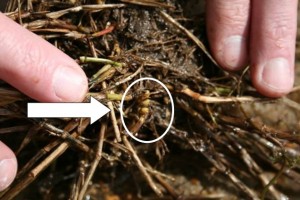By Jeff Via
This perennial foxtail, aka knotroot
foxtail, Setaria parviflora is a beast of a weed!!! More and more calls
are coming in, after many folks discover they have it. We even had a producer
in Georgia call the other day. Not sure if you have this type of foxtail? Well,
it’s easy to identify, this perennial has fibrous roots with short, knotty
rhizomes (picture below). Apparently as stated in one of the previous blogs, a
species shift from the more easily controlled grass weeds, to a predominance of
knotroot foxtail has occurred in many fields.

This year, many producers applied a
dormant spray of paraquat or glyphosate or a combination of one of those with
pendimethalin at varying rates. The fields that had the higher rates of
pendimethalin showed better suppression of the seedling perennial and annual
foxtail. Other fields had both perennial and seedling foxtail coming up after a
glyphosate/pendimethalin treatment. Not sure the reason why the seedlings came
up but this was probably due to too much rain. Rain is needed to activate the
pendimethalin but not too much. One thing to note, the pendimethalin will do
nothing to the perennial foxtail plants already in the field.
Since only a limited amount of
research has been conducted in states south of Tennessee (where knotroot foxtail
is more prevalent) with results showing that even the most effective treatments
(Pastora or Pastora plus glyphosate) only providing suppression of the weed. To
date, no treatments have been identified that provide complete control.
In a normal year, our recommendations
would be to apply a dormant spray for winter weeds and then apply Pastora at
1.5 oz./acre + glyphosate (8 oz./ acre of a 4 lb./gal. product or equivalent)
with a non-ionic surfactant at 1 qt./100 gal. 3-5 days after first cutting for
knotroot foxtail suppression. This treatment could then be followed by 1
oz./acre Pastora or Pastora plus glyphosate10-14 days later if the weeds try to
recover.
With the warmer than normal
temperatures this year and the rapid early growth of the foxtail, troublesome
fields needed to be treated prior to first cutting. We decided to treat fields
with the perennial foxtail when they reached 8-10 inches in height. In many of
these fields, seedlings were coming up as well.
Since only a limited amount of
research had been conducted in states south of Tennessee (where knotroot
foxtail is more prevalent) and the results show that even the most effective
treatments (Pastora or Pastora plus glyphosate) only provide suppression of the
weed. We decided to do some research in state.
On
March 28, 2012, Extension agents in Fayette and Shelby County along with help
from BASF put out a research plot targeting perennial foxtail. This plot was
located in a field where the perennial foxtail pressure was heavy. The field was treated with varying rates of
pendimethalin (Prowl H2O) (1.5 qts.,
2qts. and 4qts.); the
plot was conducted where 2 quarts of
Prowl H20 was applied along with glyphosate as a dormant spray. Go to our website to see the
treatments applied to the plot:
The remainder of the
field was sprayed with Pastora at 1.5 oz. plus 8oz. of the 4lb./gal. glyphosate
plus a surfactant at 1 quart/ 100 gal. After monitoring the plot/field, we
rated both for injury and suppression/control to see how the different
applications affected the perennial foxtail.
Ratings were conducted on April 13,
2012. The table on our website contains the ratings.
The producer had reduced growth and discoloration
of the bermudagrass following the applications but was aware of this ahead of
time and knew this was part of the process to suppress the perennial foxtail.
This was temporary and the bermudagrass recovered.
The field/plot was fertilized on 4/19/2012 with 80-20-40 and then cut for hay on 5/20/2012. On 5/25/2012 the
producer applied Pastora
at 1.0 oz. plus 8oz. of the 4lb./gal. glyphosate plus a surfactant at 1 quart/
100 gal. to the field leaving out the plot.
On
6/12/2012, again with help from BASF, the plot received its second shots. See the website for treatments applied to the
plot:
After monitoring the
plot/field, we rated both again for injury and suppression/control to see how
the different applications affected the perennial foxtail. Ratings were conducted on June 26, 2012 (Table 1 above).
The above listed treatments are
experimental and not labeled for use in hayfields with the exception of
Plateau. UT’s recommendation again, is a dormant spray of paraquat or
glyphosate or a combination of this with pendimethalin followed by Pastora at
1.5 oz./acre + glyphosate (8 oz./ acre of a 4 lb./gal. product or equivalent)
with a non-ionic surfactant at 1 qt./100 gal. 3-5 days after cutting. Then
Pastora at 1.0 oz./acre + glyphosate (8 oz./ acre of a 4 lb./gal. product or equivalent)
with a non-ionic surfactant at 1 qt./100 gal. 10-14 days later if the weeds try
to recover. This treatment is subject to change depending on the year. This
year was one we had to tweak.
After reviewing the data from the plot and the field, we
were able to get roughly 85% suppression and the farmer was pleased. More
research will continue the remainder of the year and again next year.


